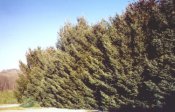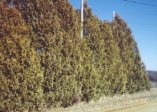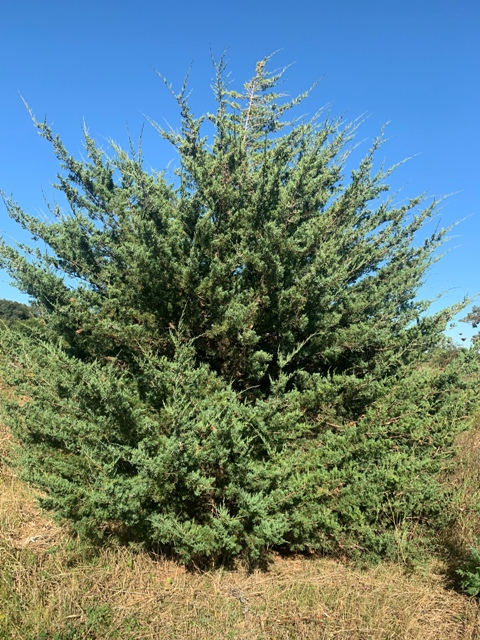Eastern Red Cedar - juniperus virginiana
For prices and sizes click here.
The Red Cedar is not really a Cedar but is actually a juniper. It has a medium growth rate of 12-24” per year with sticky foliage that is a dull green from spring to fall, and in the winter can be green or turn brown or purple. In the open its branches extend to the ground giving excellent protection. It is native to most of the US from Canada to Florida and Texas. Plant trees that come from your native area if possible for best survival.
It normally grows 30 or more ft tall with some specimens reaching over 80 ft and 30 ft wide. It can live a very long life with some specimens in Iowa are over 500 years old on rocky high spots. Wind and ice storms sometimes damage its small root system and weak wood. Deer will usually not eat this species, have seen some damage by rabbits in a very bad winter. The female plants have a large number of berries that many kinds of birds eat.
Red Cedar windbreak along a gravel road.
It will grow in hardiness zones from 2-9 with the shape being variable from columnar to pyramidal, in the north it tends to be the latter. Will grow in the poorest of soils and does not prefer the better or moist soils. It seems the higher the soil PH the better this plant likes it and will “grow in the middle of a gravel road” and be happy. Likes an airy, sunny site.
Seeds on Red Cedar, Many birds like to eat these. Plants are either male or female.
This species will tolerate hot, dry weather better than any evergreen here in Iowa. The red Cedar when planted in windbreaks are usually not effected by a fungal disease called phonopsis if they get full sun exposure. For best results plant on inside or outside of windbreaks to give maximum wind and sun exposure. On wet years it can be worse and on dry years seems to disappear. Should not be planted in low areas or in high moisture areas along water areas to reduce this problem. The red cedar also carries a fungus (a gooey glob of orange tentacles on its branches) that causes a leaf and fruit spot on apple trees, so if you want to grow some apple trees also consider this problem. Excellent plant for dry sandy areas where other species would not survive. When Iowa was first settled this is what the pioneers used for windbreaks and in a few places they are still growing.
A 2ft-potted tree can be over 8 ft tall in 5 years in well-drained, low moisture soil, and weed and grass control at the base of the tree. Spacing- Single row 4-12 ft apart, Double row 14 ft apart between rows and plants, multiple rows 20 ft between rows and plants.
The Red Cedar is a recommended windbreak tree but consider all the conditions above when selecting this tree. It is highly recommended for a single row windbreak.
Kelly Tree Farm, 191 Quincy Ave. Clarence IA 52216 - PH: 563-452-4300 - ktf@netins.net






